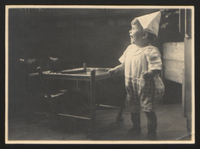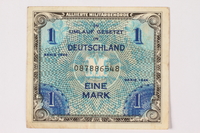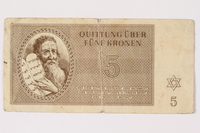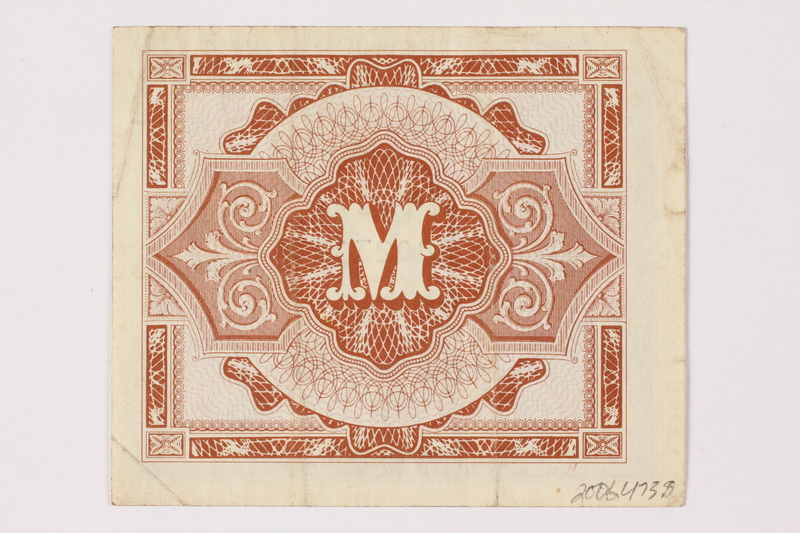Overview
- Brief Narrative
- Allied military currency, 1/2 mark, acquired by Ruth Kittel while she and her sister, Hannelore, were living with their Jewish mother, Marie (Maria), and Catholic father, Josef, in Berlin, Germany, during the Holocaust. Military currency or occupation money was produced for use by military personnel in occupied territories. The notes for different currencies: lire, francs, kroner, marks, schillings, and yen, had similar designs for ease of production. On September 19, 1941, 14 year old Ruth picked-up government mandated Judenstern or Star of David badges from the Office of the Jewish Organization because she, Hannelore, 17, and Maria had to wear one at all times to identify themselves as Jewish. In spring 1942, Jewish schools were closed, and Ruth had to register as a forced laborer with the Work Office for Jews. In November, Ruth was assigned to the Osram light bulb factory. On February 27, 1943, she was taken from Osram and transported to a collection camp on Lehrter Street and then another on Rosen Street. On March 6, she was released. In May, Ruth returned to her forced labor detail, and worked at several factories. On May 7, 1945, Germany surrendered. On August 22, 1946, Ruth, Hannelore, Maria, and Josef immigrated to the United States.
- Date
-
issue:
1944
- Geography
-
issue:
Germany
- Credit Line
- United States Holocaust Memorial Museum Collection, Gift of Ron and Susan Miller
- Markings
- face, top, center, printed, white : ALLIIERTE MILITÄRBEHÖRDE [ALLIED MILITARY]
face, left and right side, printed vertically, green ink : ½ / MARK / ½
face, top center, printed, green ink : IN / UMLAUF GESETZT / IN / DEUTSCHLAND / SERIE 1944 [IN / CURRENT LAW / IN / GERMANY / SERIES 1944]
face, center, printed, black ink : 058023943
face, bottom center, printed, green ink : FÜNFZIG / PFENNIG / SERIE 1944 [FIFTY / CENTS / SERIES 1944] - Contributor
-
Subject:
Ruth Miller
Issuer: Allied Military Government in Occupied Territory
- Biography
-
Ruth Kittel was born on July 21, 1927, in Berlin, Germany, to Josef and Marie (Maria) Ritter Kittel. Josef Kittel, a businessman and World War I veteran, was born on February 5, 1896, in Vienna, Austria, to Catholic parents. Maria was born on July 29, 1896, in Orzegow, Germany, to Jewish parents. Ruth’s older sister, Hannelore, was born on March 12, 1924. In January 1933, Adolf Hitler was appointed Chancellor of Germany. In spring 1934, Ruth was enrolled in her local public school in the Neukolln borough of Berlin. She was also enrolled at the Jewish religious school run by Rabbi Dr. Kantorowitz to study Hebrew and Jewish teachings. The sisters actively participated in Jewish life and were members of a congregation.
Following the September 15, 1935, passage of the Nuremberg Laws, Ruth and Hannelore were classified as persons with mixed Jewish blood, mischlinge, and subject to anti-Jewish restrictions and laws. In spring 1938, the German government passed laws to remove Jewish students from public schools. Ruth had to enroll at the Jewish middle school in her borough, which was managed by the Jewish Religious Organization of Berlin. Ruth, her sister Hannelore, and their mother, Maria, had to register with the local police, district number 214, and were recorded as Jews. On February 14, 1939, they each received a numbered Jewish identification card with a large red letter J and the added middle name Sara to make them identifiably Jewish. Ruth’s card was numbered A. 611790. In September, World War II began after Germany invaded Poland.
On September 19, 1941, 14 year old Ruth reported to the office of the Jewish Organization to pick up Star of David or Judenstern badges, which she always had to wear to indicate she was Jewish. Non-Jewish children her age regularly ridiculed Ruth because she wore the Star of David. Ruth never had enough to eat because the Organization distributed ration cards for food, but Jews received reduced rations. The anti-Jewish regulations also required Ruth to have a special pass to use public transportation, but she was banned from most public places, such as parks. Her mother could only shop for necessities during the one hour allotted for Jews to shop. Beginning in October, many Jews from Berlin were deported to German occupied regions to the east. Many of Ruth’s teachers and classmates were deported, and it became very difficult to attend school.
In June 1942, the Jewish Organization was dissolved, and all Jewish schools were closed. Ruth, Hannelore, and Maria had to register with the Berlin work office for Jews, which assigned registrants to work 60 hours per week at one of many designated German companies. On November 24, Ruth began working as a forced laborer on the assembly line at the Osram light bulb factory. She worked in a specially designated Jewish department under the supervision of the Gestapo. Ruth earned 30 Reichsmarks per week. On February 27, 1943, members of the SS took Ruth and the entire Jewish department from Osram to a collection camp on Lehrter Street. Ruth was transported by truck and forced into a small, crowded space with other Jews. The SS members randomly whipped people and shot into the crowd. Ruth had no access to food, bathroom facilities, or space to lie down. On her third day, she was given some turnip soup and then transported to a collection camp on Rosen Street. The conditions there were terrible, although Ruth did get some turnip soup daily. On March 6, Ruth was released because her paper work proved she was mischlinge. On May 5, Ruth’s forced labor service continued at the Luftschiffbau Zeppelin factory in the Tempelhof-Schoneberg borough. In September, the factory was destroyed and Ruth was moved to the W. Jakubaschk factory, where she made buttons. In February 1945, the button factory was destroyed. Beginning in March, Ruth worked as a seamstress on the night shift at the Fa. Schultz factory.
On May 7, Germany surrendered and Ruth, Hannelore, and Maria were free. The family registered with UNRRA as displaced persons. Ruth enrolled in the Teaching Institute at the Business and Language School in Berlin, where she studied English. In November, Ruth became a secretary for the American Jewish Joint Distribution Committee. On August 7, 1946, the Kittel family travelled to Bremen, Germany. On August 22, Ruth, Hannelore, Maria, and Josef boarded the S.S. Marine Perch and sailed for the United States. They settled in Queens, New York. In 1954, Ruth met Harold Gabriel, a Jewish man from Berlin, where he had been a forced laborer during the war. In 1948, he had emigrated from Germany. In 1955, Ruth and Harold married and their son was born a year later. In 1960, the couple divorced. In 1963, Ruth married Abe Miller, a non-German man, who adopted her son. In 1964, Harold returned to Berlin, where he later died. Ruth, age 71, died on May 8, 1999.
Physical Details
- Language
- German
- Classification
-
Exchange Media
- Category
-
Money
- Object Type
-
Military currency (lcsh)
- Physical Description
- Square currency on light brown paper with a face in light blue-green ink with an abstract leafy underprint. At the center is a white M overlaid by a black latticework design, within a black decorative border with German text at the top. Printed in green ink, the denomination, ½, is in each corner and type of currency, a mark, is along the left and right sides. The serial number is in the center, with German text above and below. The reverse is in red-brown ink, with a large white M inside a quatrefoil in the center of an ornate, circular medallion within a square, geometric patterned frame. It is discolored, stained, and creased throughout.
- Dimensions
- overall: Height: 2.625 inches (6.668 cm) | Width: 3.125 inches (7.938 cm)
- Materials
- overall : paper, ink
Rights & Restrictions
- Conditions on Access
- No restrictions on access
- Conditions on Use
- No restrictions on use
Keywords & Subjects
- Topical Term
- Children of interfaith marriage--Germany--Berlin--Biography. Forced labor--Germany--Berlin--Biography. Holocaust, Jewish (1939-1945)--Germany--Berlin--Personal narratives. Jewish children in the Holocaust--Germany--Berlin--Biography. Jews--Persecutions--Germany--Berlin--Biography. World War, 1939-1945--Refugees--United States--Personal narratives.
Administrative Notes
- Legal Status
- Permanent Collection
- Provenance
- The currency was donated to the United States Holocaust Memorial Museum in 2006 by Ron and Susan Miller, the son and daughter-in-law of Ruth Kittel Miller.
- Funding Note
- The cataloging of this artifact has been supported by a grant from the Conference on Jewish Material Claims Against Germany.
- Record last modified:
- 2022-07-28 18:26:55
- This page:
- https://collections.ushmm.org/search/catalog/irn61202
Also in Ruth Kittel Miller family collection
The collection consists of six Star of David badges, two German bank notes, Theresienstadt scrip, correspondence, documents, and photographs relating to the experiences of Ruth Kittel (later Miller) and her family in Berlin, Germany, before, during, and after the Holocaust until their emigration to the United States in 1946.
Date: 1893-1946

Ruth Miller papers
Document
The Ruth Miller papers consist of biographical materials, correspondence, photographs, and printed materials documenting the Kittel family from Berlin, Josef Kittel’s Catholic ancestry, wartime persecutions, and the Kittels’ immigration to the United States. Biographical materials include birth, marriage, and death certificates; school records; military papers; medical records; identification papers; ration coupons; employment records; immigration and travel papers; certificates of naturalization and social security cards for Josef, Marie, and Ruth Kittel. This series also includes Ruth’s release paper from the Rosenstrasse detention center, ration coupons for Hannelore Kittel, birth certificates for ancestors Josefa Gross, Anna Franziska Krieger, Franziska Steffan, Josef Kittel, Sr., Karl Kittel, and Johan Stephan, and a death certificate for Franziska Kittel. Correspondence primarily consists of correspondence documenting Josef Kittel’s genealogy. It also includes a 1942 letter to Ruth from a friend name Ellen conveying Ellen’s wartime anxiety, and a 1975 letter to Ruth from the Bundesversicherungsanstalt für Angestellte about insurance payments. Photographs comprised three photograph albums. The first album includes photographs of Ruth Miller, the Kittel family, friends who perished in the Holocaust (some wearing yellow stars), bombed out buildings in postwar Berlin, soccer games, demonstrations, trains preparing to depart for displaced persons camps, the Kittels’ ship en route to America. The second album also includes photographs of Ruth Miller, the Kittel family, friends and classmates, after the war in Germany, and in America. The third album also include photographs of the Kittel family, their ancestors, Josef Kittel in uniform during World War I (with postcards written on the backs from Josef to Marie), the Kittels’ ship en route to America, and life in America. Printed materials include a brief pamphlet published by Jewish Friends Society containing the lyrics to “The Star‐Spangled Banner” in English and Hebrew and a map of Germany divided in quadrants and centered on Berlin.

Allied Military Authority currency, German 1 mark, acquired by a female forced laborer
Object
Allied military currency, 1 mark, acquired by Ruth Kittel while she and her sister, Hannelore, were living with their Jewish mother, Marie (Maria), and Catholic father, Josef, in Berlin, Germany, during the Holocaust. Military currency or occupation money was produced for use by military personnel in occupied territories. The notes for different currencies: lire, francs, kroner, marks, schillings, and yen, had similar designs for ease of production. On September 19, 1941, 14 year old Ruth picked-up government mandated Judenstern or Star of David badges from the Office of the Jewish Organization because she, Hannelore, 17, and Maria had to wear one at all times to identify themselves as Jewish. In spring 1942, Jewish schools were closed, and Ruth had to register as a forced laborer with the Work Office for Jews. In November, Ruth was assigned to the Osram light bulb factory. On February 27, 1943, she was taken from Osram and transported to a collection camp on Lehrter Street and then another on Rosen Street. On March 6, she was released. In May, Ruth returned to her forced labor detail, and worked at several factories. On May 7, 1945, Germany surrendered. On August 22, 1946, Ruth, Hannelore, Maria, and Josef immigrated to the United States.

Theresienstadt ghetto-labor camp scrip, 5 kronen note, acquired by a female forced laborer
Object
Scrip valued at 5 kronen, acquired by Ruth Kittel while she and her sister, Hannelore, were living with their Jewish mother, Marie (Maria), and Catholic father, Josef, in Berlin, Germany, during the Holocaust. All currency was confiscated from deportees upon entry to Theresienstadt ghetto-labor camp and replaced with scrip and ration coupons that could be exchanged only in the camp. On September 19, 1941, 14 year old Ruth picked-up government mandated Judenstern or Star of David badges from the Office of the Jewish Organization because she, Hannelore, 17, and Maria had to wear one at all times to identify themselves as Jewish. In spring 1942, Jewish schools were closed, and Ruth had to register as a forced laborer with the Work Office for Jews. In November, Ruth was assigned to the Osram light bulb factory. On February 27, 1943, she was taken from Osram and transported to a collection camp on Lehrter Street and then another on Rosen Street. On March 6, she was released. In May, Ruth returned to her forced labor detail, and worked at several factories. On May 7, 1945, Germany surrendered. On August 22, 1946, Ruth, Hannelore, Maria, and Josef immigrated to the United States.
Unused Star of David badge with Jude for Jew owned by a young woman assigned to forced labor
Object
Yellow cloth Star of David badge, not yet cut from square, received but not used by Ruth Kittel, her sister, Hannelore, or their Jewish mother, Marie, while living with their Catholic father Josef under the Nazi dictatorship in Berlin, Germany. On September 19, 1941, 14 year old Ruth picked up government mandated Judenstern from the Office of the Jewish Organization because she, Hannelore, 17, and Maria had to wear one at all times to identify themselves as Jewish. In spring 1942, her Jewish school closed, and Ruth had to register as a forced laborer with the Work Office for Jews. In November, Ruth was assigned to the Osram light bulb factory. On February 27, 1943, she was taken from Osram and transported to two collection camps untile her release on March 6. Ruth returned in May to her forced labor detail. On May 7, 1945, Germany surrendered. Ruth, Hannelore, Maria, and Josef immigrated to the US on August 26, 1946.
Star of David badge with Jude for Jew worn by a young woman assigned to forced labor
Object
Yellow cloth Star of David badge worn by Ruth Kittel, her sister, Hannelore, or their Jewish mother, Marie, while living with their Catholic father Josef under the Nazi dictatorship in Berlin, Germany. On September 19, 1941, 14 year old Ruth picked up government mandated Judenstern from the Office of the Jewish Organization because she, Hannelore, 17, and Maria had to wear one at all times to identify themselves as Jewish. In spring 1942, her Jewish school closed, and Ruth had to register as a forced laborer with the Work Office for Jews. In November, Ruth was assigned to the Osram light bulb factory. On February 27, 1943, she was taken from Osram and transported to two collection camps untile her release on March 6. Ruth returned in May to her forced labor detail. On May 7, 1945, Germany surrendered. Ruth, Hannelore, Maria, and Josef immigrated to the US on August 26, 1946.
Star of David badge with Jude for Jew worn by a young woman assigned to forced labor
Object
Yellow cloth Star of David badge worn by Ruth Kittel, her sister, Hannelore, or their Jewish mother, Marie, while living with their Catholic father Josef under the Nazi dictatorship in Berlin, Germany. On September 19, 1941, 14 year old Ruth picked up government mandated Judenstern from the Office of the Jewish Organization because she, Hannelore, 17, and Maria had to wear one at all times to identify themselves as Jewish. In spring 1942, her Jewish school closed, and Ruth had to register as a forced laborer with the Work Office for Jews. In November, Ruth was assigned to the Osram light bulb factory. On February 27, 1943, she was taken from Osram and transported to two collection camps untile her release on March 6. Ruth returned in May to her forced labor detail. On May 7, 1945, Germany surrendered. Ruth, Hannelore, Maria, and Josef immigrated to the US on August 26, 1946.
Unused Star of David badge with Jude for Jew owned by a young woman assigned to forced labor
Object
Yellow cloth Star of David badge received but not used by Ruth Kittel, her sister, Hannelore, or their Jewish mother, Marie, while living with their Catholic father Josef under the Nazi dictatorship in Berlin, Germany. On September 19, 1941, 14 year old Ruth picked up government mandated Judenstern from the Office of the Jewish Organization because she, Hannelore, 17, and Maria had to wear one at all times to identify themselves as Jewish. In spring 1942, her Jewish school closed, and Ruth had to register as a forced laborer with the Work Office for Jews. In November, Ruth was assigned to the Osram light bulb factory. On February 27, 1943, she was taken from Osram and transported to two collection camps untile her release on March 6. Ruth returned in May to her forced labor detail. On May 7, 1945, Germany surrendered. Ruth, Hannelore, Maria, and Josef immigrated to the US on August 26, 1946.
Star of David badge with Jude for Jew worn by a young woman assigned to forced labor
Object
Yellow cloth Star of David badge worn by Ruth Kittel, her sister, Hannelore, or their Jewish mother, Marie, while living with their Catholic father Josef under the Nazi dictatorship in Berlin, Germany. On September 19, 1941, 14 year old Ruth picked up government mandated Judenstern from the Office of the Jewish Organization because she, Hannelore, 17, and Maria had to wear one at all times to identify themselves as Jewish. In spring 1942, her Jewish school closed, and Ruth had to register as a forced laborer with the Work Office for Jews. In November, Ruth was assigned to the Osram light bulb factory. On February 27, 1943, she was taken from Osram and transported to two collection camps untile her release on March 6. Ruth returned in May to her forced labor detail. On May 7, 1945, Germany surrendered. Ruth, Hannelore, Maria, and Josef immigrated to the US on August 26, 1946.
Star of David badge with Jude for Jew worn by a young woman assigned to forced labor
Object
Yellow cloth Star of David badge worn by Ruth Kittel, her sister, Hannelore, or their Jewish mother, Marie, while living with their Catholic father Josef under the Nazi dictatorship in Berlin, Germany. On September 19, 1941, 14 year old Ruth picked up government mandated Judenstern from the Office of the Jewish Organization because she, Hannelore, 17, and Maria had to wear one at all times to identify themselves as Jewish. In spring 1942, her Jewish school closed, and Ruth had to register as a forced laborer with the Work Office for Jews. In November, Ruth was assigned to the Osram light bulb factory. On February 27, 1943, she was taken from Osram and transported to two collection camps untile her release on March 6. Ruth returned in May to her forced labor detail. On May 7, 1945, Germany surrendered. Ruth, Hannelore, Maria, and Josef immigrated to the US on August 26, 1946.





